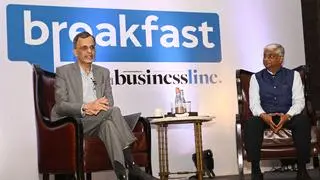India is facing a variety of factors that may shake its sovereign credit metrics, S&P Global Ratings said on Wednesday. Currently, the agency has ‘BBB- with a stable outlook’ investment grade on India.
‘BBB-(negative)’ is the lowest investment grade rating. Technically, ‘stable outlook’ means a rating that is not likely to change.
Andrew Wood, sovereign analyst at S&P Global Ratings pointed out that India’s foreign exchange reserves are falling and current account deficit is rising amid external turbulence.
RBI’s weekly statistical supplement showed that forex reserves fell to $532.66 billion in the week through September 30, the lowest level since July 2020. Notably, the reserves plummeted by $10 billion in 13 months.
Meanwhile, India’s current account recorded a deficit of $23.9 billion (2.8 per cent of GDP) in the first quarter, up from $13.4 billion (1.5 per cent of GDP) in January-March period of the last fiscal.
Wood mentioned that the economy is battling rising inflation and tightening financial conditions both at home and overseas.
India‘s strong economic growth rate has long been an important counterbalance to its high fiscal deficit and debt burden, and its sound external balance sheet helps to buffer against global market turbulence. He expects these strengths to help neutralise the risks inherent in the treacherous global environment.
“Under more severe conditions though, a few factors could have the potential to apply downward pressure on our sovereign credit ratings on India,” he said.
CURRENT ACCOUNT UNDER STRESS
S&P Global Ratings issued a credit FAQ (Frequently Asked Questions) on various factors.
On the risks posed by falling foreign exchange reserves and rising current account deficit, agency said the fall in its foreign exchange reserves is driven in part by the country’s growing current account deficit which is projected to reach 3 per cent of GDP in the current fiscal year. In FY22, the current account deficit was pegged at 1.6 per cent.
Related Stories
India offers 26 E&P blocks covering 2.3 lakh sq km to US oil firms
India is keen on inviting US oil firms to invest in the country’s exploration & production (E&P) sector.The agency expects the prices of commodities, especially the prices of energy, will stabilise around current levels through 2023, after which they may decline more meaningfully. This would alleviate the pressure on India‘s current account, and is a key assumption supporting firm’s expectations for the deficit to decline gradually through fiscal 2026.
Nevertheless, “if its current account deficit remains higher for longer, compared with our current base case forecasts, that would impinge on India‘s external balance sheet,” it said.
IMPACT OF INFLATION
On the impact of higher inflation and tighter monetary conditions, the agency said external trends are fuelling higher consumer price inflation and interest rates in India, and there is a possibility that this trend lasting at least through the remainder of fiscal 2023.
“We expect the RBI’s policy rate to end fiscal 2023 at 5.9 per cent versus 4 per cent prior to the commencement of the tightening cycle. Higher rates and faster price increases will somewhat suppress consumer behaviour, and this could soften near-term growth momentum,” it said.








Comments
Comments have to be in English, and in full sentences. They cannot be abusive or personal. Please abide by our community guidelines for posting your comments.
We have migrated to a new commenting platform. If you are already a registered user of TheHindu Businessline and logged in, you may continue to engage with our articles. If you do not have an account please register and login to post comments. Users can access their older comments by logging into their accounts on Vuukle.